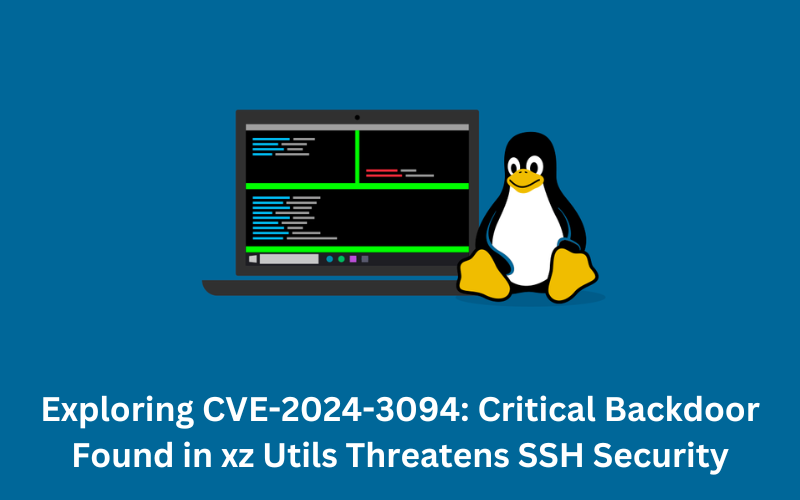Good day & welcome to the cutting-edge Linux security press! Now, you will be taken into the very core of a recent reveal that was unsettling the Linux community. Picture this: a door to the surveillance is opened in the name of a utility called xz Utils. Which intends to end SSH’s reputation! While going through this trip, let us see how this loophole, anonymously tagged CVE-2024-3094.
Discovered its way into the beat of all Linux based systems before targeting the core element that is most paramount for the work of SSH. Join us as we pull the curtains apart & study the functionalities of this Linux supply-chain attack. Moreover, we will highlight the likely impacts & speedily respond to the possible damages (worldwide).
Major Backdoor Discovered in xz Utils Puts SSH Security at Risk
Image credit – Double Pulsar
Recently, the Linux community was rocked by a significant security revelation. A vital backdoor was exposed in an XZ Utils, which is the popular compression tool. This stealthside belongs to CVE-2024-3095 & using the maximum score (10.0). Creepily targeted one of the most critical aspects of xz Utils -. Containing is in SSH, the widely used secure remote access protocol in several Linux systems which is the primary protocol.
Understanding the Threat
Image credit – Medium
A certain backdoor had come to light in the xz Utils release of 5.6.0 & 5.6.1. Meaning it had been carefully designed to suit the needs of these particular updates. The intrusion was done melting through a supply chain attack. One of the more complex methods that enable hackers to embed the backdoor during the software creation stage. By infiltrating the entire supply chain process therefore eventually getting a backdoor in compromised releases.
In particular, it made extensive use of SSH spoofing to gain access. Successfully combating this vulnerability can give a threat actor. An unofficial access to remote protected systems, therefore providing them with full control of the affected system. Impacts of that kind of access can be data sniffing. Deploying more malicious codes, or the abuse of the access for an illicit goal.
Impact & Swift Response
Widespread Use of zz Utils in these various Linux distributions made the consequences of this vulnerability to be Extremely Potent. Despite this, quick response from the crisis management team prevented extensive damages. Security researchers got the backdoor while having unrelated SSH performance issues’ inspection. And the buzz was in the Openwall mailing list immediately on March 29th, 2024.
Response Measures:
- Security Advisories: The publicly available attack vector code has offered a key into critical systems using popular Linux distributions. Namely Red Hat, Debian & Ubuntu, some of whose users were informed urgently through security advisories.
- Patch Deployment: They reacted by providing updates consisting of these features designed to eliminate the backdoor itself in their software repository. The versioning exercise of patching xz Utils in place of the original was emphasised. As the main mitigating activity advised for the users.
- Identifying Compromised Systems: Awareness about the emergent nature of the need to uncover indicators of compromise (IOCs). That is backdoor-specific, security teams had to turn their thought processes to this priority. This preventive activity meant quick-witted counteraction to incidents which could be a source of systematic risks.
Mitigating the Risk
For Linux users, proactive measures were crucial in mitigating the risk posed by this vulnerability:
1. Update xz Utils: The users’ attention was especially caught on the importance of using a timely update mechanism for the popular xz Utils. This having been done, the “fixed” version (correcting the backdoor issue) was installed on their systems.
2. Verify System Integrity: Aside from repairing, users were prompted to put extra security measures such as system sovereignty verification & detecting malicious activity. The addition was proposed due to feedback from distribution providers about checking. For IOCs jamming the xz Utils backdoor & seeking assistance from them.
Key Takeaways & Reflection
Herein, the case clearly shows the unparalleled significance of software supply chain security. And the fact that one should always stay on guard in the Linux community. One can give a user the know-how on staying informed, applying security patches on time.
And adhering to best practices which will reduce the chances that the vulnerabilities would affect their systems. This situation is an eye-opener regarding the expanding danger spectrum & the fact that the system must remain alert. Against clever assaults aimed at the basic units of critical software infrastructure.
Frequently Asked Questions
Here are some frequently asked questions:
1. What Vulnerability was Discovered in xz Utils, & What Component Did Hit?
- The sophisticated gateway, denoted as CVE-2024-3094, was uncovered in versions 5.6.0 & 5.6.1 of xz Utils. It was this key component, the atomic , which was at the heart of SSH utilisation.
2. What was the exploit vector & how did an attacker get it?
- The attack happened as a backdoor inserted via a supply chain attack. An attack where an attacker compromises the software development process itself. Which allows the attacker to introduce backdoor during creating the xz Utils releases.
3. What risk did the hacking method represent for Linux security?
- The backdoor seemed to have the potential to intercept the SSH authentication process, somehow getting into the unsecured systems. It could result in full takeover of the breached systems, data theft, & even follow up with more malicious load onto the machinery.
4. How long did it take for the backdoor being discovered to be made public Knowledge & reaction of the Linux community?
- Notification of breach was posted on March 29, 2024 in the openwall web page. It wasn’t long before the Linux community rushed in to help, major distributions listed the flaw. As a critical security vulnerability & advised users & system administrators that the hole in the security should be plugged.
5. What was the procedure that was proposed for Linux users, who were informed about the backdoor, as for recovery?
- Linux users’ necessity of upgrading to the latest patched product release of xz Utils was announced by all distributors. And also gladly they provide this via a simple patch-open point. More importantly, users were also directed to see additional precautionary measures. Especially when verifying system integrity & cyberspace compromise were systematically checked.
Conclusion
At the end, the finding of a major lever in xz Users is unambiguous evidence of the never-ending struggle in Linux security. Initially, the publicity might have led to worried voices, but the prompt reaction of security researchers. And the operating systems were indicative of the robustness & concerted effort of the community.
When we are considering the cyber-security field where external threats always lie, watchfulness is extremely important. The continuing efforts of keeping ourselves aware, getting the latest security patches applied. And cultivating the culture of defence by design. As well as allow for a stronger defence positioned against emerging gaps on Linux security. Let this be our motto from now on; guardians keeping track of all moves in the digital limbo.







